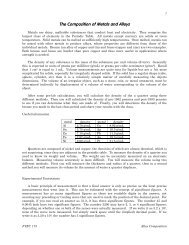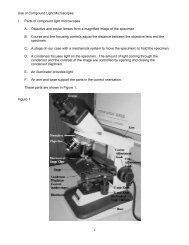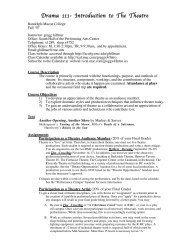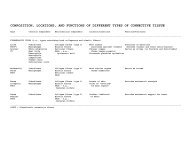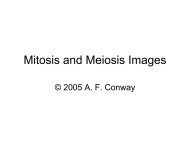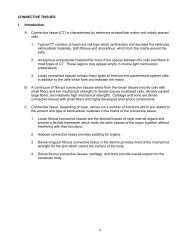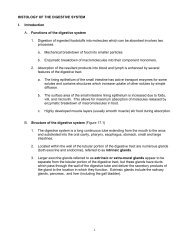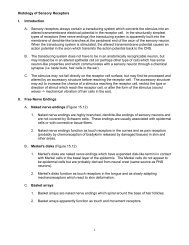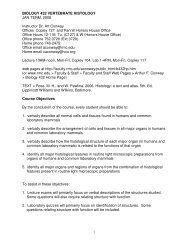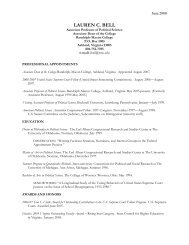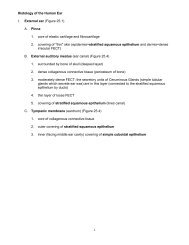Functoriality for the su3 Khovanov homology 1 ... - Faculty.rmc.edu
Functoriality for the su3 Khovanov homology 1 ... - Faculty.rmc.edu
Functoriality for the su3 Khovanov homology 1 ... - Faculty.rmc.edu
Create successful ePaper yourself
Turn your PDF publications into a flip-book with our unique Google optimized e-Paper software.
<strong>Functoriality</strong> <strong>for</strong> <strong>the</strong> su 3 <strong>Khovanov</strong> <strong>homology</strong>DAVID CLARKWe prove that <strong>the</strong> categorified su 3 quantum link invariant is functorialwith respect to tangle cobordisms. This is in contrast to <strong>the</strong> categorifiedsu 2 <strong>the</strong>ory [8, 1], which was not functorial as originally defined [7, 5].We use methods of Morrison and Nieh [12] and Bar-Natan [2] to constructexplicit chain maps <strong>for</strong> each variation of <strong>the</strong> third Reidemeister move.Then, to show functoriality, we modify arguments used by Clark, Morrison,and Walker [5] to show that induced chain maps are invariant, up tohomotopy, under Carter and Saito’s movie moves [4, 3].57M25; 57M27, 57Q451 Introduction1.1 The su 3 link invariant and its categorification<strong>Khovanov</strong> first categorified <strong>the</strong> su 3 link invariant in [9]. It was later generalizedby MacKaay and Vaz in [11], and independently by Morrison and Niehin [12]. The latter paper gives a local geometric construction in <strong>the</strong> spirit ofBar-Natan [1], using <strong>the</strong> language of planar algebras and canopoleis 1 . Indeed,<strong>the</strong> su 3 quantum link invariant can be thought of as a map of planar algebras,defined on generators by↦→ q 2 − q 3↦→ −q −3+ q −21We find this to be a pleasing plural <strong>for</strong>m of canopolis, and surely <strong>the</strong> purest from<strong>the</strong> standpoint of Greek etymology (cf. metropolis, metropoleis [15]). By way of analogy,<strong>for</strong>mulae : <strong>for</strong>mulas : : canopoleis : canopolises.
2 David Clarkand subject to <strong>the</strong> relations of Kuperberg’s su 3 spider [10](1)= q 2 + 1 + q −2(2)= q + q −1(3)= +which will r<strong>edu</strong>ce a Z[q, q −1 ]-linear combination of trivalent graphs (“webs”)to a polynomial.Morrison and Nieh use a technique similar to Bar-Natan’s [1] to categorifythis map of planar algebras. The new source category (technically a canopolis)Ortang is that of oriented tangles and <strong>the</strong>ir cobordisms, and <strong>the</strong> target categoryKob (su 3 ) consists of <strong>for</strong>mal complexes of webs with chain maps given byseamed cobordisms (“foams”). In [12], it is shown that this categorified map,which we’ll call Kh(su 3 ) (technically a canopolis morphism), is well-defined onobjects, i.e., isotopy of a tangle does not change <strong>the</strong> homotopy type of <strong>the</strong> imagecomplex. Put yet ano<strong>the</strong>r way, “Kh(su 3 ), considered to be valued in <strong>the</strong>category of chain complexes up to homotopy equivalence, is a link invariant.”1.2 Main resultWhat’s not shown in [12] is whe<strong>the</strong>r Kh(su 3 ) is truly functorial, i.e., that it isalso well-defined on morphisms (up-to-isotopy tangle cobordisms), and thusan honest map of canopoleis. Conveniently, we can view a tangle cobordismin 4-space as a sequence of tangle diagrams called a “movie”. 2 Fur<strong>the</strong>r, anycobordism admits a movie presentation such that <strong>the</strong> tangles in subsequentframes differ by ei<strong>the</strong>r a single Reidemeister move or a single Morse move(<strong>the</strong> birth or death of a circle, or <strong>the</strong> splicing of two strands). This partitioningof a cobordism C into simple combinatorial steps gives us an obvious way toattempt a definition of a chain map Kh(su 3 )(C).Thanks to Carter and Saito [3, 4] (and also Roseman [13]), <strong>the</strong>re is also a wayto view isotopies of tangle cobordisms in this movie presentation context: two2There is some subtlety here about being able to assume that such cobordisms arein general position; this is addressed carefully in [5].
<strong>Functoriality</strong> <strong>for</strong> <strong>the</strong> su 3 <strong>Khovanov</strong> <strong>homology</strong> 3tangle cobordisms are isotopic if and only if <strong>the</strong>y are related by a sequence of<strong>the</strong> movie moves 3 in Figure 1. Thus Kh(su 3 ) is only well-defined if it yieldshomotopic chain maps when applied to <strong>the</strong> cobordism on each side of everymovie move.MM1MM2MM3MM4MM5MM6MM7MM8MM9MM10MM11MM12MM13 MM14 MM15Figure 1: Carter and Saito’s unoriented movie moves, numbered according to Bar-Natan [1]. Note that first ten moves are circular, and so should be paired with <strong>the</strong>constant movie of <strong>the</strong> first frame.This turned out not to be <strong>the</strong> case in <strong>for</strong> <strong>the</strong> categorified su 2 invariant [8, 1],as first documented by Jacobsson [7]: certain movie moves changed <strong>the</strong> signof <strong>the</strong> induced chain map. This issue was resolved in [5] with a modifiedconstruction designed to incorporate a previously neglected piece of represen-3In an oriented <strong>the</strong>ory, like <strong>the</strong> one in this paper, one must consider all possible orientationsof <strong>the</strong>se moves, in addition to <strong>the</strong> usual variations resulting from reflectionsand crossing changes.
4 David Clarktation <strong>the</strong>ory: <strong>the</strong> fact that <strong>the</strong> fundamental representation of su 2 is antisymmetricallyself-dual, and <strong>the</strong> source of <strong>the</strong> sign anomaly.The categorified su 3 invariant was shown to be functorial up to a sign byMackaay and Vaz [11] using an argument of Bar-Natan [1]. However, <strong>the</strong> representation<strong>the</strong>oretic problem <strong>for</strong> su 2 does not exist <strong>for</strong> su 3 , whose fundamentalrepresentations are dual to each o<strong>the</strong>r, but not self-dual. This, along withsome experimental evidence, led Morrison and Nieh to conjecture that <strong>the</strong> su 3<strong>the</strong>ory is honestly functorial, with no sign anomaly. In this paper, we’ll proveit as a <strong>the</strong>orem.Theorem 1.3 Kh(su 3 ) : Ortang → Kob (su 3 ) is a canopolis morphism; in particular,oriented tangle cobordisms induce well-defined (up to homotopy) chainmaps in Kob (su 3 ).In Section 2 we’ll review <strong>the</strong> su 3 <strong>the</strong>ory of Morrison and Nieh. Much of <strong>the</strong>work comes in Section 3, when we explicitly define <strong>the</strong> induced maps <strong>for</strong> orientedReidemeister moves. In Section 4 we’ll look at <strong>the</strong> induced maps on eachside of <strong>the</strong> movie moves, and see that in each case <strong>the</strong>y are homotopic. Finally,in Section 5, we will briefly discuss <strong>the</strong> possible extension of this <strong>the</strong>ory toWebCob, <strong>the</strong> category of knotted webs and seamed cobordisms in four-space.AcknowledgementsThe author would like to thank Justin Roberts and Scott Morrison <strong>for</strong> manyuseful discussions. Additional thanks are due to Scott Morrison and Ari Nieh<strong>for</strong> allowing me access to <strong>the</strong>ir wonderful foam diagrams, and to Scott Carterand Masahico Saito <strong>for</strong> letting me reuse <strong>the</strong>ir movie move diagrams from [4].Thanks also to <strong>the</strong> referee <strong>for</strong> helpful comments and corrections.2 The su 3 <strong>the</strong>ory2.1 Planar algebras and canopoleisWe’ll give a brief recap of <strong>the</strong> construction of Morrison and Nieh here, andrefer <strong>the</strong> reader to [1], [12], and [14] <strong>for</strong> more technical details regarding planaralgebras and canopoleis.
6 David Clark⎛⎞12:⎜⎝,↦−→⎟⎠Figure 3: A planar algebra: <strong>the</strong> operad action on oriented tangle diagrams.we quotient by <strong>the</strong> su 3 spider{relations}(Equations 1); <strong>the</strong> spider is generated,as a planar algebra, by , . We can thus view <strong>the</strong> su 3 quantumlink invariant as a map of planar algebras, which is convenient <strong>for</strong> both computationalefficiency and organizing philosophy.The goal, <strong>the</strong>n, is to categorify this local picture of a quantum invariant: to dothis, we invoke <strong>the</strong> notion of a canopolis, first appearing in [1].Definition 2.3 A canopolis is a planar algebra in some (monoidal 4 ) categoryof categories (C(s i )). In particular, both <strong>the</strong> collection of objects and <strong>the</strong> collectionof morphisms <strong>for</strong>m planar algebras.Now a planar arc diagram P will define a functor P : C(s 1 ) × ... × C(s n ) → C(s 0 ).We can view each category C(s) as a “can” (ra<strong>the</strong>r than just a disc) with aspecified label s that can be plugged into a cylinder with a matching label inP × [0, 1]: objects will live on <strong>the</strong> tops and bottoms of cans, and morphismswill live inside cans. Fur<strong>the</strong>r, <strong>the</strong> fact that P defines a functor guarantees thatplanar operations commute with <strong>the</strong> usual composition of morphisms within<strong>the</strong>ir categories. Thus, we can build a “city of cans” by composing verticallyor horizontally in any order. It will also be useful to talk about maps betweencanopoleis.Definition 2.4 A canopolis morphism C → C ′ is a collection of functors(C(s i )) → (C ′ (s i ))that commute with all planar algebra operations.4Here <strong>the</strong> monoidal structure is just given by cartesian product.
<strong>Functoriality</strong> <strong>for</strong> <strong>the</strong> su 3 <strong>Khovanov</strong> <strong>homology</strong> 7Our first example of a canopolis will be <strong>the</strong> categorification of <strong>the</strong> set of orientedtangles. Let Ortang(s) be <strong>the</strong> category of tangle cobordisms with fixedboundary denoted by s ∈ S , where S indexes <strong>the</strong> set of strand intersectionswith <strong>the</strong> boundary circle and <strong>the</strong>ir orientations, up to cyclic permutation. Thenwe define Ortang to be <strong>the</strong> canopolis in <strong>the</strong> category ⋃ s∈SOrtang(s). (Notethat we need more than just <strong>the</strong> cobordisms between two individual crossingsto generate all possible tangle cobordisms.) Here we want all morphisms consider<strong>edu</strong>p to four-dimensional isotopy; when viewing a generic morphism asa movie of tangle diagrams, this means we mod out by <strong>the</strong> movie moves.2.5 Categorifying <strong>the</strong> su 3 spiderA more interesting example, because it involves relations, is <strong>the</strong> categorificationof <strong>the</strong> su 3 spider. Let Cob (su 3 ) s be <strong>the</strong> category of cans with fixed boundaryas above: <strong>the</strong> objects are su 3 webs and <strong>the</strong> morphisms are seamed cobordisms(or foams), which are just CW-complexes modeled on “Y" × [0, 1], plussome additional data.Definition 2.6 (from [12]) Given two webs D 1 and D 2 drawn in a disc, bothwith boundary ∂ , a seamed cobordism from D 1 to D 2 is a 2-dimensional CWcomplexF with• exactly three oriented 2-cells meeting along each oriented singular 1-cell, such that <strong>the</strong> orientations on <strong>the</strong> 2-cells all induce <strong>the</strong> same orientationon <strong>the</strong> seam;• a cyclic ordering on those three 2-cells;• and an identification of <strong>the</strong> boundary of F with D 1 ∪D 2 ∪(∂ ×[0, 1]) suchthat– <strong>the</strong> orientations on <strong>the</strong> sheets induce <strong>the</strong> orientations on <strong>the</strong> edgesof D 1 , and <strong>the</strong> opposite orientations on <strong>the</strong> edges of D 2 ,– and <strong>the</strong> cyclic orderings around <strong>the</strong> singular seams agree with <strong>the</strong>cyclic orderings around a vertex in D 1 or D 2 given by its embeddingin <strong>the</strong> disc; <strong>the</strong> anticlockwise ordering <strong>for</strong> “inwards” vertices,<strong>the</strong> clockwise ordering <strong>for</strong> “outwards” vertices.Note that a foam is an abstract space; while its boundary is identified withlines on <strong>the</strong> surface of <strong>the</strong> can D 2 × [0, 1] (and thus it is picturesque to viewfoams as in Figure 4), <strong>the</strong> foam doesn’t literally live in <strong>the</strong> can.
<strong>Functoriality</strong> <strong>for</strong> <strong>the</strong> su 3 <strong>Khovanov</strong> <strong>homology</strong> 9• The “three rocket” relation:(8) + + = 0• The “seam-swap” relation: reversing <strong>the</strong> cyclic order of <strong>the</strong> three 2-cellsattached to a closed singular seam is equivalent to multiplication by −1.• The “sheet relations” (which can be derived from <strong>the</strong> relations above):(9)= 0 = −3(10)= 0 = 0Remark.The first of <strong>the</strong>se four is <strong>the</strong> extremely useful “blister relation.”(1) Cob (su 3 ) is generated, as a canopolis, by <strong>the</strong> cup, cap, saddle, zip, andunzip morphisms below.(2) As a consequence of <strong>the</strong> local relations, all closed foams in Cob (su 3 ) canbe evaluated to scalars. (Lemma 3.3 in [12])As it turns out, Cob (su 3 ) will benefit from slightly more structure. First we’llmake it into a graded canopolis by endowing web diagrams with <strong>for</strong>mal gradingshifts given by powers of q. Fur<strong>the</strong>r, define <strong>the</strong> grading of a morphism Cfrom q m 1D 1 to q m 2D 2 by(11)deg C = 2χ(C) − B + V 2 + m 2 − m 1where B is <strong>the</strong> number of boundary points on D i and V is <strong>the</strong> total number oftrivalent vertices in <strong>the</strong> webs D 1 and D 2 . Note that <strong>the</strong> local relations above
<strong>Functoriality</strong> <strong>for</strong> <strong>the</strong> su 3 <strong>Khovanov</strong> <strong>homology</strong> 11These crossings will compose under planar operations to make larger tangles,as will <strong>the</strong> associated complexes. One important subtlety is that planar compositionof complexes is independent of <strong>the</strong> order of composition, up to chainisomorphism, but this isomorphism is not <strong>the</strong> obvious permutation: one needsto sprinkle some minus signs into <strong>the</strong> permutation to make it a chain map. Theupshot is that (1) <strong>for</strong> well-definition of complexes, all crossings in a tangle diagrammust be equipped with an ordering (of course, this is equivalent to <strong>the</strong>ordering of holes in a planar arc diagram), and (2) <strong>the</strong>re are (slightly) nontrivialchain maps that will reorder <strong>the</strong> crossings. See Appendix B.2 <strong>for</strong> details.To complete our map on objects, we need only check that <strong>the</strong> map Kh(su 3 ) isinvariant under isotopy of tangles, i.e., that Reidemeister moves applied to<strong>the</strong> source tangle do not change <strong>the</strong> homotopy type of <strong>the</strong> resulting complex.This is essentially done in [12] by constructing a chain homotopy equivalence<strong>for</strong> each version of <strong>the</strong> oriented Reidemeister moves, though we will provideadditional details in Section 3.2.8 A canopolis morphism?There is a natural way to define Kh(su 3 ) on morphisms (tangle cobordisms)as well. Since a surface in 4-space can be presented by a movie, we can viewa cobordism as a sequence of tangles diagrams that, at each stage, differ bya Reidemeister or Morse move. Thus we need only define chain maps <strong>for</strong><strong>the</strong>se six generating moves. This is easy: Morse moves induce <strong>the</strong> obviousgluing of 0-, 1-, or 2-handles into a foam, and Reidmeister moves already havechain maps defined <strong>for</strong> <strong>the</strong> link <strong>homology</strong>. Again, <strong>the</strong> heart of <strong>the</strong> issue here iswhe<strong>the</strong>r <strong>the</strong>se induced maps are well-defined, i.e., invariant under <strong>the</strong> moviemoves. If <strong>the</strong>y are, <strong>the</strong>n Kh(su 3 ) is a canopolis morphism.3 Reidemeister maps3.1 The Reidemeister one and two mapsWe’ll take <strong>the</strong>se (more or less) directly from <strong>the</strong>ir definition in [12], where <strong>the</strong>yare derived and proven to be homotopy equivalences. The Reidemeister onemaps are shown in Figures 5 and 6 <strong>for</strong> <strong>the</strong> positive (R1a) and negative (R1b)twist, respectively.
12 David ClarkFigure 5: A homotopy equivalence <strong>for</strong> R1a: <strong>the</strong> positive twist.Figure 6: A homotopy equivalence <strong>for</strong> R1b: <strong>the</strong> negative twist.The Reidemeister two maps come in two flavors, parallel or antiparallel, and<strong>the</strong> maps are given in Figures 7 and 8. Note that changing which strand movesover top does not change our maps, except that we will always use <strong>the</strong> followingordering convention: <strong>the</strong> negative crossing is 1, and <strong>the</strong> positive crossingis 2.It’s also worth noting that our antiparallel map (Figure 8) is −1 times <strong>the</strong> originalmap in [12]; we’re free to multiply any of <strong>the</strong>se maps by a scalar, andsome brief experimentation confirms that this particular scalar, in this particularplace, is needed <strong>for</strong> functoriality.3.2 The Reidemeister three mapsHere we have some work to do: in order to compute movie move maps, we’llneed to know <strong>the</strong> R3 maps explicitly, <strong>for</strong> every flavor of <strong>the</strong> move. The “cat-
<strong>Functoriality</strong> <strong>for</strong> <strong>the</strong> su 3 <strong>Khovanov</strong> <strong>homology</strong> 13+ -idFigure 7: A homotopy equivalence <strong>for</strong> R2a: parallel strands.egorified Kauffman trick” (CKT) (first used by Bar-Natan in [1] and <strong>the</strong>n byMorrison and Nieh in [12]) provides an efficient method <strong>for</strong> computing <strong>the</strong> R3maps.There are eight different versions of <strong>the</strong> oriented Reidemeister three move,and we’ll use <strong>the</strong>m all <strong>for</strong> <strong>the</strong> movie move calculations. To use <strong>the</strong> CKT here,we’ll first need to look at some smaller complexes: <strong>the</strong> “be<strong>for</strong>e” and “after”complexes of <strong>the</strong> move that slides a strand past a trivalent vertex. There areeight variations of this move: <strong>the</strong> vertex can be a sink or a source, and <strong>the</strong>moving strand can lie on top or below <strong>the</strong> vertex strands and can be orientedin two possible ways. For convenience, let’s name <strong>the</strong>m based on whe<strong>the</strong>r <strong>the</strong>vertex strands point I(n) or O(ut), <strong>the</strong> crossing strand is A(bove) or B(elow)<strong>the</strong> vertex strands, and <strong>the</strong> crossing strand is oriented L(eft) or R(ight). Thefollowing lemmas from [12] provide homotopy equivalences 6 <strong>for</strong> two of <strong>the</strong>variations using Bar-Natan’s simplification algorithm [2].Lemma 3.3 (IBL variation: Lemma 4.4 in [12]) The complex⎛⎞[ ]q 51 2 =( z ⎜⎝ q4 ) ⊕ ( −z z ) q 6 ⎟q 5 ⎠6Note that <strong>the</strong>se maps include both homological and q-grading shifts, and so arenot completely honest homotopy equivalences of <strong>the</strong> two sides of <strong>the</strong> move.
<strong>Functoriality</strong> <strong>for</strong> <strong>the</strong> su 3 <strong>Khovanov</strong> <strong>homology</strong> 15Figure 9: The maps d, b, r, and ¯r.is homotopy equivalent to <strong>the</strong> complex(q 8 [ ][+2] =via <strong>the</strong> simplifying map s OBL , given byq 5 u q 6 )s OBL,0 = ( 0 ) s OBL,1 = ( z ◦ d −1 ) s OBL,2 = ( r ) .Remark. Again we’ll need <strong>the</strong> inverse map t OBL , which is given by( ) b ◦ ut OBL,1 =t OBL,2 = ( −¯r ) .−1Explicit homotopy equivalences <strong>for</strong> <strong>the</strong> o<strong>the</strong>r six variations of <strong>the</strong> “strand-pastvertex”move are given below.Lemma 3.5 (1) IBR: The complex⎛[1 2]=⎜⎝ q−6( u−u)q −5 ⊕q −5 ( u u ) q −4⎞⎟⎠is homotopy equivalent to <strong>the</strong> complex[ ] ()q −8 [−2] = q −6 u q −5via <strong>the</strong> simplifying map s IBR , given bys IBR,−2 = ( r ) s IBR,−1 = ( −z ◦ d 1 ) s IBR,0 = ( 0 ) .The inverse map t IBR is given byt IBR,−2 = ( −¯r ) ( ) −b ◦ ut IBR,−1 = .1
16 David Clark(2) OBR: The complex⎛⎞[1 2]=⎜⎝q −6( ) −u uq −5 ⊕q −5 ( u u ) q −4⎟⎠is homotopy equivalent to <strong>the</strong> complex[ ] ()q −8 [−2] = q −6 u q −5via <strong>the</strong> simplifying map s OBR , given bys OBR,−2 = ( r ) s OBR,−1 = ( z ◦ d −1 ) s OBR,0 = ( 0 ) .The inverse map t OBR is given byt OBR,−2 = ( −¯r ) t OBR,−1 =( ) b ◦ u.−1(3) IAR: The complex⎛[ ]1 2 =( z⎜⎝ q4 )⎞q 5⊕ ( z −z ) q 6 ⎟q 5 ⎠is homotopy equivalent to <strong>the</strong> complex[ ] ()q 8 [+2] = q 5 u q 6via <strong>the</strong> simplifying map s IAR , given bys IAR,0 = ( 0 ) s IAR,1 = ( z ◦ d −1 ) s IAR,2 = ( r ) .The inverse map t IAR is given by( ) b ◦ ut IAR,1 =−1t IAR,2 = ( −¯r ) .
18 David Clark(6) OAL: The complex⎛⎞[1 2]=⎜⎝q −6( u−u)q −5 ⊕q −5 ( u u ) q −4⎟⎠is homotopy equivalent to <strong>the</strong> complex[ ] ()q −8 [−2] = q −6 u q −5via <strong>the</strong> simplifying map s OAL , given bys OAL,−2 = ( r ) s OAL,−1 = ( −z ◦ d 1 ) s OAL,0 = ( 0 ) .The inverse map t OAL is given byt OAL,−2 = ( −¯r ) ( ) −b ◦ ut OAL,−1 = .1Proof See Appendix A.5.Remark. Notice that, modulo orientations, reflections, and rotations, <strong>the</strong> abovecomplexes are very similar. This leads us to make <strong>the</strong> following observations,which we’ll use when computing <strong>the</strong> R3 moves:(1) For moves IBL, OBL, IAR, and OAR, <strong>the</strong> lowest homological componentof <strong>the</strong> s map, which originates at <strong>the</strong> doubly smoothly-resolved object,is zero; <strong>the</strong> highest component is <strong>the</strong> half-barrel r.(2) For moves IBR, OBR, IAL, and OAL, <strong>the</strong> highest homological componentof <strong>the</strong> s map, which originates at <strong>the</strong> doubly I-resolved object, is zero;<strong>the</strong> lowest component is r.Be<strong>for</strong>e explicitly computing <strong>the</strong> eight R3 maps, we’ll need some basic resultsfrom homological algebra.Definition 3.6 Given a chain map f : A • → B • , <strong>the</strong> cone over f is C(f ) • =A •+1 ⊕ B • , with differential(dAd C(f ) =f)0−d B
<strong>Functoriality</strong> <strong>for</strong> <strong>the</strong> su 3 <strong>Khovanov</strong> <strong>homology</strong> 19Definition 3.7 A map r : B • → C • is a strong de<strong>for</strong>mation retract 7 with inversei if• 1 B − ir = d B h + hd B ;• 1 C = ri; and• hi = rh = 0,where h : B • → B •−1 .Remark. Each s map above is a strong de<strong>for</strong>mation retract with inverse t; seeAppendix A.The following two lemmas about cones were first presented and proven in [1];we’ll refer to <strong>the</strong>m as “cone-r<strong>edu</strong>cing” lemmas:Lemma 3.8 If f : A • → B • is a chain map, r : B • → C • is a strong de<strong>for</strong>mationretract, and i : C • → B • is <strong>the</strong> inverse of r via <strong>the</strong> homotopy h, <strong>the</strong>n <strong>the</strong> coneC(rf ) is homotopic to <strong>the</strong> cone C(f ), via( 1 0−hf iC(f ) • = A •+1 ⊕ B • ( ) 1 00 r) A •+1 ⊕ C • = C(rf ) •Lemma 3.9 If f : B • → A • is a chain map, r : B • → C • is a strong de<strong>for</strong>mationretract, and i : C • → B • is <strong>the</strong> inverse of r via <strong>the</strong> homotopy h, <strong>the</strong>n <strong>the</strong> coneC(fi) is homotopic to <strong>the</strong> cone C(f ), via( ) i 00 1C(f ) • = B •+1 ⊕ A • ( ) r 0fh 1 C •+1 ⊕ A • = C(fi) •We’ll also need <strong>the</strong>se two, which are proven analogously:Lemma 3.10 If f : C • → A • is a chain map, r : B • → C • is a strong de<strong>for</strong>mationretract, and i : C • → B • is <strong>the</strong> inverse of r via <strong>the</strong> homotopy h, <strong>the</strong>n <strong>the</strong> coneC(fr) is homotopic to <strong>the</strong> cone C(f ), via( ) r 00 1C(f ) • = C •+1 ⊕ A • ( ) i 00 1 B •+1 ⊕ A • = C(fr) •7In [12] this is called a simple homotopy equivalence.
20 David ClarkLemma 3.11 If f : A • → C • is a chain map, r : B • → C • is a strong de<strong>for</strong>mationretract, and i : C • → B • is <strong>the</strong> inverse of r via <strong>the</strong> homotopy h, <strong>the</strong>n <strong>the</strong> coneC(if ) is homotopic to <strong>the</strong> cone C(f ), via( ) 1 00 rC(f ) • = A •+1 ⊕ C • ( ) 1 00 i A •+1 ⊕ B • = C(if ) •Now we’re ready to attack <strong>the</strong> R3 complexes <strong>the</strong>mselves. First, let’s name<strong>the</strong> eight variations, six of which are braidlike and two of which are starlike.As in [5], we’ll label <strong>the</strong> braidlike moves by circling anticlockwise around <strong>the</strong>tangle boundary and recording <strong>the</strong> height of each outgoing strand (h <strong>for</strong> high,m <strong>for</strong> middle, and l <strong>for</strong> low). The starlike moves are labeled ei<strong>the</strong>r clockwiseor anticlockwise, depending on which way we have to circle to see <strong>the</strong> low,middle, and <strong>the</strong>n high outgoing strands. We also need to pick a time direction<strong>for</strong> each move, and will use <strong>the</strong> convention that <strong>the</strong> “be<strong>for</strong>e” diagram has acrossing to <strong>the</strong> right of <strong>the</strong> low strand, while <strong>the</strong> “after” diagram has a crossingto <strong>the</strong> left. All of <strong>the</strong>se labels and conventions are shown in Figure 10.R3 hmlR3 −1hmlR3 hlmR3 −1hlmR3 lhmR3 −1lhmR3 mhlR3 −1mhlR3 mlhR3 −1mlhR3 lmhR3 −1lmhR3 R3 −1R3 R3 −1Figure 10: The eight variations of <strong>the</strong> R3 move.
<strong>Functoriality</strong> <strong>for</strong> <strong>the</strong> su 3 <strong>Khovanov</strong> <strong>homology</strong> 21The CKT works by decomposing <strong>the</strong> nine-object “be<strong>for</strong>e” and “after” complexesof an R3 move as cones over <strong>the</strong> local differential <strong>for</strong> a particular crossing.For <strong>the</strong> time being, let’s take this to be <strong>the</strong> highest crossing. It’s importantat this point to introduce ano<strong>the</strong>r set of conventions: <strong>the</strong> way in which weorder crossings. For variations hml, lmh, mlh, and , we’ll use <strong>the</strong> followingordering: in <strong>the</strong> initial tangle <strong>the</strong> crossings will be ordered ‘middle’, ‘low’,‘high’, while in <strong>the</strong> final tangle <strong>the</strong>y will be ordered ‘low’, ‘middle’, ‘high’. Forvariations lhm, mhl, hlm, , we’ll instead use <strong>the</strong> inverse ordering: <strong>the</strong> crossingsof <strong>the</strong> initial tangle will be ordered ‘low’, ‘middle’, ‘high’, and of <strong>the</strong> finaltangle, ‘middle’, ‘low’, ‘high’. 8Consider, <strong>for</strong> example, <strong>the</strong> initial complex of <strong>the</strong> hml move:[[ ]] ⎛⎞3∼= C ⎝z−−−→above⎠ ,1 21 21 2where z above is <strong>the</strong> zip differential <strong>for</strong> <strong>the</strong> high crossing. Morrison and Niehused this decomposition, as well as <strong>the</strong> one <strong>for</strong> <strong>the</strong> final complex of <strong>the</strong> hmlmove, to show that <strong>the</strong> two complexes were homotopy equivalent. We willrestate <strong>the</strong>ir argument from [12] here, while fleshing out some more details togive us an explicit map.Remark. The initial and final tangles in <strong>the</strong> Propositions below may be rotatedrelative to <strong>the</strong>ir definitions in Figure 10, <strong>for</strong> convenience.First we need an easy lemma.Lemma 3.12 The two compositions1 2z1 2s IBLand1 2z 1 2s OBL ,using <strong>the</strong> maps defined in Lemmas 3.4 and 3.3, are equal.8This ordering convention is more cumbersome still than <strong>the</strong> one used in [5], andeven worse must be altered when we resolve <strong>the</strong> low crossing instead of <strong>the</strong> high. Itis a necessary evil, though, as <strong>the</strong> alert reader may notice as we work though <strong>the</strong> CKT<strong>for</strong> <strong>the</strong> different variations.
24 David Clark(3) The lmh variation.⎛⎞⎛⎞[[231]]∼= C⎜⎝u above≃−−→ Cflmh⎟ ⎜⎠ ⎝u below∼=⎟⎠[[123]]is a homotopy equivalence via <strong>the</strong> map( )tIBR ◦ sf lmh =OBR 0.u ◦ h OBR 1The homotopy inverse of this map is given by( )tOBR ◦ sg lmh =IBR 0.u ◦ h IBR 1Remark. Notice that, <strong>for</strong> <strong>the</strong> mhl and lmh variations, <strong>the</strong> interesting partialhomotopy equivalences occur at <strong>the</strong> source complexes in <strong>the</strong> cones, ra<strong>the</strong>r than<strong>the</strong> target complexes. Thus <strong>the</strong> relevant cone-r<strong>edu</strong>cing lemma here is Lemma3.9.For <strong>the</strong> hlm, mlh, , and variations of R3, <strong>the</strong> high crossing resolves parallelto <strong>the</strong> low strand, ra<strong>the</strong>r than perpendicular to it, which makes <strong>the</strong> coneslightly more complicated. Consider, <strong>for</strong> example, <strong>the</strong> complexes in <strong>the</strong> move. The initial complex is[[ ]] ()3z ∼= C −−−→above,212121with final complex[[123]] (∼= C1 2z below−−−→21).Here nei<strong>the</strong>r <strong>the</strong> source nor target complexes in <strong>the</strong> cones are <strong>the</strong> same; instead,<strong>the</strong> source complexes are related by two R2 moves, and <strong>the</strong> target complexesby a different sequence of strand-past-vertex moves. This will ultimately makeour string of homotopy equivalences longer, but <strong>the</strong> idea is essentially <strong>the</strong>same. As be<strong>for</strong>e, we’ll give <strong>the</strong> gory details in only one of <strong>the</strong> cases.First, however, we’ll need a statement analogous to Lemma 3.12.
<strong>Functoriality</strong> <strong>for</strong> <strong>the</strong> su 3 <strong>Khovanov</strong> <strong>homology</strong> 25Lemma 3.15 The two compositionsρ 121z213t IBR21andρ 21 2σ2 1z 213t OBR21,are equal. Here, ρ 1 and ρ 2 are <strong>the</strong> R2 tuck maps on <strong>the</strong> bottom two strands andon <strong>the</strong> top two strands, respectively, and σ is <strong>the</strong> obvious crossing-reorderingmap.Proof Again, as in <strong>the</strong> proof of Lemma 3.12, this is a straight<strong>for</strong>ward exercisein foam isotopy. Just remember that σ is <strong>the</strong> identity on all objects except <strong>the</strong>doubly I-resolved ones, on which it acts by −1.Proposition 3.16 (The version of R3)⎛ ⎞⎛⎞[[231]]∼= C⎜⎝21z above≃−→ Cf⎟ ⎜⎠ ⎝221z below1∼=⎟⎠[[123]]21is a homotopy equivalence via <strong>the</strong> map( σ ◦ ρ2 ◦ ρ −1)f =10.s OBR ◦ t IBR ◦ z ◦ h 1 s OBR ◦ t IBRThe homotopy inverse of this map is given by(ρ1 ◦ ρ −1)g =2◦ σ 0.s IBR ◦ t OBR ◦ z ◦ h 2 s IBR ◦ t OBRHere, <strong>the</strong> maps h 1 and h 2 are homotopies <strong>for</strong> <strong>the</strong> R2 equivalences, and wewon’t compute <strong>the</strong>m explicitly.
28 David Clark(3) The variation.⎛⎞⎛⎞[[231]]∼= C⎜⎝u above≃−→ Cf⎟ ⎜⎠ ⎝u below∼=⎟⎠[[123]]is a homotopy equivalence via <strong>the</strong> map()sf =OBR ◦ t IBR 0−h 1 ◦ u ◦ s OBR ◦ t IBR σ ◦ ρ 2 ◦ ρ −1 .1The homotopy inverse of this map is given by()sg =IBR ◦ t OBR 0−h 2 ◦ u ◦ s IBR ◦ t OBR ρ 1 ◦ ρ −1 .2◦ σRemark. The proof <strong>for</strong> <strong>the</strong> hlm variation uses Lemmas 3.11 and 3.9, as in <strong>the</strong> case above, while <strong>the</strong> and mlh variations require Lemmas 3.10 and 3.8.Having determined <strong>the</strong> R3 maps explicitly, we see <strong>the</strong>y are various and complicated.However, to compute with movie moves we only need a small list offacts that apply to all eight R3 variations. The following lemmas provide thisdistillation, and apply to both <strong>the</strong> R3 moves and <strong>the</strong>ir inverses.First, we’ll reintroduce some notation from [5]. As we’ve seen, <strong>the</strong> CKT essentiallyseparates each R3 “be<strong>for</strong>e” and “after” complex into two smaller complexes,which we’ll call “layers,” whose diagrams differ by <strong>the</strong> resolution ofa single crossing. We’ll denote layers that look like (a rotated version of) ei<strong>the</strong>ror by O, since <strong>the</strong> strands involved in <strong>the</strong> crossing appear tobe Orthogonal to <strong>the</strong> uninvolved strand. In contrast, we’ll denote layers thatlook like (a rotated version of) ei<strong>the</strong>r or by P , <strong>for</strong> “P arallel to <strong>the</strong>uninvolved strand.” Notice that <strong>the</strong> homological ordering of <strong>the</strong> layers may beei<strong>the</strong>r O → P or P → O, depending on <strong>the</strong> crossing signs and orientations <strong>for</strong>each R3 move:• <strong>the</strong> hml, lhm, mlh, and variations are ordered O → P• <strong>the</strong> mhl, lmh, hlm, and variations are ordered P → O
<strong>Functoriality</strong> <strong>for</strong> <strong>the</strong> su 3 <strong>Khovanov</strong> <strong>homology</strong> 29This allows us to decompose each R3 map asR3 ⋆ = R3 O→O⋆+ R3 O→P⋆+ R3 P→O⋆+ R3 P→P⋆ ,where ⋆ is one of <strong>the</strong> eight variations and R3 a→b⋆ is <strong>the</strong> component from <strong>the</strong> alayer to <strong>the</strong> b layer. Of course, we’ve already per<strong>for</strong>med this decomposition in<strong>the</strong> propositions above. For example, <strong>the</strong> matrix <strong>for</strong> f (from Proposition 3.17,part (3)) can be written, using this notation, as⎛⎝R3 O→OR3 P→OR3 O→PR3 P→P⎞⎠ .Let’s also name a morphism that will arise frequently:R = .Lemma 3.18 If <strong>the</strong> layers of R3 ⋆ are arranged as O → P , <strong>the</strong>n <strong>the</strong> map from<strong>the</strong> parallel layer to <strong>the</strong> orthogonal layer, R3 P→O⋆ , is zero. O<strong>the</strong>rwise, if <strong>the</strong>layers are arranged as P → O, <strong>the</strong>n <strong>the</strong> map R3 P→O⋆ is zero. (That is, <strong>the</strong>diagonal map pointing backwards in homological height is always zero.)Lemma 3.19 The map between <strong>the</strong> orthogonal layers, R3 O→O⋆ , is <strong>the</strong> identitychain map when ⋆ = hml, lhm, mhl, or lmh. When ⋆ = hlm or mlh, <strong>the</strong> mapR3 O→O⋆ , restricted to <strong>the</strong> two homologically extreme objects, is −id. When⋆ = or , <strong>the</strong> restriction of R3 O→O⋆ to extreme objects is <strong>the</strong> appropriaterotation of <strong>the</strong> morphism −R.Lemma 3.20 The map between <strong>the</strong> parallel layers, R3 P→P⋆ , kills <strong>the</strong> doublysmoothly-resolved object (which resides at ei<strong>the</strong>r <strong>the</strong> highest or lowest homologicalheight) when ⋆ = hml, lhm, mhl, or lmh, and kills both extreme objectswhen ⋆ = hlm, mlh, , or . Fur<strong>the</strong>r, <strong>for</strong> each variation, in <strong>the</strong> middle homologicalheight <strong>the</strong>re is a pair of objects (one in <strong>the</strong> source complex and one in<strong>the</strong> target complex) that have <strong>the</strong> same unoriented diagram; <strong>the</strong> component of<strong>the</strong> R3 P→P⋆ map between <strong>the</strong>se objects is −id <strong>for</strong> ⋆ = hml, lhm, mhl or lmh, <strong>the</strong>
30 David Clarkidentity <strong>for</strong> ⋆ = hlm or mlh, and <strong>the</strong> appropriate rotation of R <strong>for</strong> ⋆ = or .Every o<strong>the</strong>r entry of <strong>the</strong> R3 P→P⋆ map in <strong>the</strong> middle homological height is somemultiple of a foam that looks locally a cup, a cap, or one of <strong>the</strong> followingnear all circles or bigons in ei<strong>the</strong>r <strong>the</strong> source or target.These lemmas follow easily by observation of our CKT complexes and directcalculation of <strong>the</strong> maps <strong>the</strong>rein, involving only foam isotopy. It turns out wewill need one more (ra<strong>the</strong>r obscure) piece of data <strong>for</strong> movie move 6, which isagain easily computed: it concerns <strong>the</strong> O → O map <strong>for</strong> <strong>the</strong> R3 variation.Lemma 3.21 The R3 O→Oin <strong>the</strong> following way:⎛R3 O→O :⎜⎝map acts on <strong>the</strong> middle homological height objects⎞⎛ ⎞⎛⎝ −T − 1⎞0 − T ′ ⎠−−−−−−−−−→⎟⎜ ⎟⎠⎝ ⎠whereT = ,and T ′ is <strong>the</strong> appropriate rotation/reflection.For our movie move calculations, it will also be convenient to have <strong>the</strong> analogouslemmas when we determine <strong>the</strong> O and P layers by resolving <strong>the</strong> lowestcrossing, ra<strong>the</strong>r than <strong>the</strong> highest. The CKT works just as well in this context,this time using <strong>the</strong> four versions of <strong>the</strong> strand-past-vertex move we haven’tseen so far (computed in Lemma 3.5). The maps look very similar to <strong>the</strong> oneswe’ve worked out above; this time, however, <strong>the</strong> hml, lmh, hlm, and mlh variationswill more closely resemble <strong>the</strong> CKT from Proposition 3.13, while <strong>the</strong>
<strong>Functoriality</strong> <strong>for</strong> <strong>the</strong> su 3 <strong>Khovanov</strong> <strong>homology</strong> 31mhl, lhm, , and variations will take after Proposition 3.16. It’s also worthnoting that a different set of crossing ordering conventions will become muchmore convenient here. For variations hml, lmh, hlm, and mlh, we’ll use <strong>the</strong> followingordering: in <strong>the</strong> initial tangle <strong>the</strong> crossings will be ordered ‘middle’,‘high’, ‘low’, while in <strong>the</strong> final tangle <strong>the</strong>y will be ordered ‘high’, ‘middle’,‘low’. For variations mhl, lhm, , and , we’ll instead use <strong>the</strong> inverse ordering:<strong>the</strong> crossings of <strong>the</strong> initial tangle will be ordered ‘high’, ‘middle’, ‘low’,and of <strong>the</strong> final tangle, ‘middle’, ‘high’, ‘low’. We’ll demonstrate two of <strong>the</strong>seR3 homotopy equivalences below (denoting <strong>the</strong>m with a bar), and leave <strong>the</strong>rest as an exercise to <strong>the</strong> reader.Proposition 3.22 (1) The hlm variation.⎛ ⎞[[31 2]]∼= C⎜⎝u above⎛≃−−→ Cf hlm⎟ ⎜⎠ ⎝u below⎞∼=⎟⎠[[ 1 23]]is a homotopy equivalence via <strong>the</strong> map( )tOAR ◦ sf hlm =IAR 0.u ◦ h IAR 1The homotopy inverse of this map is given by( )tIAR ◦ sg hlm =OAR 0.u ◦ h OAR 1(2) The lhm variation.⎛⎞⎛⎞[[31 2]]∼= C⎜⎝u above≃−−→ Cf lhm⎟ ⎜⎠ ⎝u below∼=⎟⎠[[ 1 23]]
<strong>Functoriality</strong> <strong>for</strong> <strong>the</strong> su 3 <strong>Khovanov</strong> <strong>homology</strong> 334 Checking movie movesHere we will prove Theorem 1.3, which asserts functoriality <strong>for</strong> <strong>the</strong> <strong>the</strong>ory.This requires showing that chain maps in Kob (su 3 ), induced by link cobordisms,are well-defined, i.e., <strong>the</strong>y are invariant under changing a cobordismpresentation by a movie move. The overall strategy will be very similar to <strong>the</strong>one used in [5].4.1 Duality and homotopy isolationWe begin by stating a result about duality with respect to Hom-sets. For tanglesP and Q, denote any gluing of <strong>the</strong>m by P•Q, and let Q denote <strong>the</strong> reflectionof Q. The following proposition was first presented in [5]:Proposition 4.2 Given oriented tangles P, Q and R, <strong>the</strong>re is an isomorphismbetween <strong>the</strong> spaces of chain maps up to homotopyF : Hom Kh ([P•Q] , [R]) ∼ = → HomKh([P] ,[R•Q]).While this result was originally proven in <strong>the</strong> context of <strong>Khovanov</strong>’s su 2 <strong>the</strong>ory,it clearly holds <strong>for</strong> <strong>the</strong> su 3 case without any changes to <strong>the</strong> statement orproof (<strong>for</strong> whose details we refer <strong>the</strong> interested reader to [5]). It’s importantto note, however, that <strong>the</strong> proof assumes <strong>the</strong> <strong>the</strong>ory is already invariant underMM9, <strong>the</strong> ninth movie move. As such, invariance under MM9, shown in Section4.10, must take place with complete independence of <strong>the</strong> material in thissection.From this we get an easy corollary, also given in [5], which will be highly usefulduring our movie move checks. In particular, note that it applies to (<strong>the</strong> firstand last frames of) every movie move.Corollary 4.3 Let T 1 and T 2 be tangles with k endpoints such that T 1 •T 2 isan unlink with m components. Then <strong>the</strong> space of chain maps modulo chainhomotopy from [T 1 ] to [T 2 ] in grading m − k is 1-dimensional, and all chainmaps of grading higher than m − k are chain homotopic to zero.The second component of machinery we’ll need is <strong>the</strong> “homotopy isolation”idea from [5].
34 David ClarkDefinition 4.4 Let C • and D • be complexes in a graded additive category,with A a direct summand in some C i . We’ll say A is C-D homotopically isolatedif, <strong>for</strong> any grading zero homotopy h : C • → D •−1 , <strong>the</strong> restriction of dh+hdto A is zero.Lemma 4.5 Let f , g : C • → D • be chain maps, and say f ≃ αg are homotopic<strong>for</strong> some scalar α. If f and g agree and are nonzero on a C-D homotopicallyisolated object A in C • , <strong>the</strong>n we have that f ≃ g are homotopic.By Corollary 4.3, we know that any movie move (except <strong>for</strong> MM9) changes <strong>the</strong>induced map in Kob (su 3 ) by at most a scalar. We’ll show this scalar is always1 by computing with homotopically isolated objects, which have a convenientdescription in <strong>the</strong> su 3 web case.Lemma 4.6 Let [T 1 ] and [T 2 ] be <strong>the</strong> complexes <strong>for</strong> two tangle diagrams, andlet D 1 be a web appearing as a direct summand somewhere in [T 1 ]. Then(1) D 1 is [T 1 ]-[T 1 ] homotopically isolated if it contains no cycles (as a graph)and is not connected by differentials to webs containing cycles;(2) D 1 is [T 1 ]-[T 2 ] homotopically isolated if [T 1 ] and [T 2 ] contain only acyclicwebs.To prove this, we’ll first need a more general result about Hom-sets of foams.Definition 4.7 The bare grading of a morphism C between webs D 1 and D 2is given bydeg ′ (C) = 2χ(C) − B + V 2 ,where B is <strong>the</strong> number of boundary points on h and V is <strong>the</strong> total number oftrivalent vertices in D 1 and D 2 .Proposition 4.8 If D 1 and D 2 are acyclic <strong>the</strong>n <strong>the</strong>re are no nonzero morphismswith positive bare grading between <strong>the</strong>m.Remark. Morrison and Nieh demonstrate a curious difference between <strong>the</strong>Hom-sets in <strong>the</strong> su 2 and su 3 <strong>the</strong>ories. In <strong>the</strong> <strong>for</strong>mer, basis webs (i.e., crossinglessmatchings) were guaranteed not to have positive morphisms between
<strong>Functoriality</strong> <strong>for</strong> <strong>the</strong> su 3 <strong>Khovanov</strong> <strong>homology</strong> 35<strong>the</strong>m. In contrast, su 3 basis webs 9 can have morphisms between <strong>the</strong>m in arbitrarilylarge positive degree [12]. Proposition 4.8 provides a condition sufficientto avoid positive morphisms: webs must be acyclic, ra<strong>the</strong>r than nonelliptic.Proof Let C : D 1 → D 2 . Our first task is to remove <strong>the</strong> closed seams fromC, producing a new foam called ˜C. Begin by per<strong>for</strong>ming neck cutting on eachsheet incident on a closed seam. (If <strong>the</strong>re are k closed seams to begin with,<strong>the</strong>re will be 3k operations). This will produce 3 3k terms, in which all <strong>the</strong> originalclosed seams are sequestered in closed foams. We can evaluate each oneof <strong>the</strong>se closed foams to a scalar by <strong>the</strong> remark in Section 2.5, leaving us witha new presentation of C = ∑ C i , a degree-homogeneous linear combination.Here <strong>the</strong> C i may still have closed seams, but only of <strong>the</strong> variety appearingin <strong>the</strong> neck cutting relation: locally, <strong>the</strong>y will all look like “choking handles”( ). At this point, we can per<strong>for</strong>m neck cutting once again (to removeunwanted tubes connecting sheets) so that each C i has <strong>the</strong> following pieces:• 0-cells given by trivalent vertices and boundary points.• 1-cells given by seams, boundary lines, and edges in D i .• 2-cells given ei<strong>the</strong>r by discs in choking handles, or by sheets that intersectD 1 ∪ D 2 nontrivially and that may have handles or choking handles.Now pick any C i ≠ 0 and consider <strong>the</strong> foam ˜C obtained from C i by removingall handles and choking handles. Since <strong>the</strong>se pieces have bare grading −1 and0, respectively, we have that deg ′ (C) = deg ′ (C i ) ≤ deg ′ (˜C). Also note that ˜C hasno closed seams and no handles, and can thus be decomposed as follows:• 0-cells given by trivalent vertices and boundary points.• 1-cells given by seams, boundary lines, and edges in D i .• 2-cells given by genus zero sheets that intersect D 1 ∪ D 2 nontrivially.It suffices to prove <strong>the</strong> result <strong>for</strong> this much simpler foam ˜C.Let F be <strong>the</strong> number of seams in ˜C, and let S be <strong>the</strong> number of sheets. We nowclaim that χ(˜C) = S − 2F, which we can see as follows. Imagine building ˜Cout of its S disjoint sheets. We’ll <strong>the</strong>n add seams, joining toge<strong>the</strong>r three sheetsat each seam. Each of <strong>the</strong>se operations will r<strong>edu</strong>ce <strong>the</strong> Euler characteristic by2, giving <strong>the</strong> <strong>for</strong>mula. Thus, since F = V 2 , deg′ (˜C) = 2S − 3F − B.9<strong>the</strong> “non-elliptic” webs, whose internal faces have at least six sides.[10]
36 David ClarkNext we’ll show that, if D 1 and D 1 are acyclic, this <strong>for</strong>mula can be modifiedto deg ′ (˜C) = 2S − 4F − N , where N = π 0 (D 1 ) + π 0 (D 2 ), i.e., <strong>the</strong> total numberof connected components of <strong>the</strong> boundary webs. Assuming D 1 and D 2 areacyclic just means that each of <strong>the</strong>ir components is a tree. This says that B =V i +2n i , where n i is <strong>the</strong> number of connected components and V i is <strong>the</strong> numberof trivalent vertices in D i . Adding <strong>the</strong>se two equations we get2B = V 1 + V 2 + 2(n 1 + n 2 )= V + 2N⇒ B = V 2 + N = F + N.Thus we have that deg ′ (˜C) = 2S − 3F − B = 2S − 4F − N .Remember, our goal is to show that deg ′ (˜C) ≤ 0, which is now equivalent toproving(12)S ≤ 2F + N 2 .We’ll get <strong>the</strong>re by considering <strong>the</strong> boundary 1-cells of <strong>the</strong> sheets in ˜C, which,as mentioned be<strong>for</strong>e, consist of seams, boundary lines, and edges in D i . It’san easy observation that <strong>the</strong> total number of edges, E, in D 1 and D 2 is justE = 2V +N . These segments, as well as <strong>the</strong> boundary lines, can serve as part of<strong>the</strong> boundary <strong>for</strong> a single sheet. Each seam, however, will serve as a boundarycomponent <strong>for</strong> three distinct sheets (from our acyclicity assumption).For an example, let’s say that every sheet in ˜C were a d-gon. Then we wouldhave that Sd = E+B+3F: each side of each sheet corresponds to a graph edge,a boundary line, or one third of a seam. Let’s make a more general assumption:that every sheet in ˜C has at least four sides. If this is <strong>the</strong> case, <strong>the</strong>n4S ≤ E + B + 3F≤ (2V + N) + (F + N) + 3F≤ 8F + 2N.This would give us Equation 12. Note that <strong>the</strong>re cannot be three-sided sheets(or in fact any odd-sided sheets, by acyclicity); un<strong>for</strong>tunately, <strong>the</strong>re can bebigons. However, we observe that bigons in ˜C must have one edge in oneof <strong>the</strong> D i and <strong>the</strong> o<strong>the</strong>r edge a seam intersecting <strong>the</strong> same D i twice. In o<strong>the</strong>rwords, this bigon must be part of a zip or unzip morphism. Thus we can factor˜C into a stack of zips, unzips, and a foam in which each sheet has at least four
<strong>Functoriality</strong> <strong>for</strong> <strong>the</strong> su 3 <strong>Khovanov</strong> <strong>homology</strong> 37sides. Since <strong>the</strong> zip and unzip morphisms have bare degree −1, we have ourresult.Proof of Lemma 4.6 A degree zero homotopy is a morphismh : q m D 1 → q m−1 D 2 .(Here, we could have D 2 in ei<strong>the</strong>r [T 1 ] or [T 2 ], depending on which part of<strong>the</strong> lemma we’re trying to prove.) Thus, by Equation 11, deg ′ (h) = 1. And byProposition 4.8, h must be <strong>the</strong> zero map.The first part of this lemma is well-suited <strong>for</strong> <strong>the</strong> reversible movie moves(MM6-10) and <strong>the</strong> second part <strong>for</strong> <strong>the</strong> those involving Morse moves. It’s aneasy observation that every web in <strong>the</strong> initial (and final) complex C of moviemoves 6, 7, and 8 is C-C homotopically isolated, and every web in <strong>the</strong> initialand final complexes C and D of 11, 13, and 15 is C-D homotopically isolated.This means we can compare induced chain maps simply by applying <strong>the</strong>m toa single object of our choice. Movie moves 12 and 14, un<strong>for</strong>tunately, do notcontain homotopically isolated objects, so we’ll need to compute <strong>the</strong> inducedmaps on all objects; luckily <strong>the</strong> complexes are small, and this is not a great burden.We’ll handle movie moves 9 and 10 with different techniques. The <strong>for</strong>merneeds special care <strong>for</strong> <strong>the</strong> reason described in <strong>the</strong> paragraph after Proposition4.2. In <strong>the</strong> case of movie move 10, we will use a r<strong>edu</strong>ndancy argument to givea computation-free proof of invariance.Keep in mind that, as always, all crossings in <strong>the</strong>se moves must be ordered,and <strong>the</strong>y may need to be reordered to be consistent with <strong>the</strong> conventions we’vedefined <strong>for</strong> <strong>the</strong> Reidemeister maps. (Recall <strong>the</strong> discussion about planar compositionsof complexes in Section 2.7 and Appendix B.2) However, <strong>the</strong> chainmaps induced by crossing reorderings are trivial in every movie move exceptMM6 and MM9. The signs appearing in MM6 are particularly nasty, but wewill show some sample calculations.4.9 MM1-5The first five movie moves are trivial; <strong>the</strong>y simply say that a Reidemeistermove followed by its inverse is <strong>the</strong> identity.
38 David Clark4.10 MM6-10Movie moves 6 through 10 involve no Morse moves, and so are reversible. Weonly need to check one time direction, and in all cases we’ll be comparing <strong>the</strong>map induced by <strong>the</strong> movie shown to <strong>the</strong> identity map (induced by <strong>the</strong> constantmovie). 10MM6There are 24 variations of MM6. To see this, we’ll first make use of rotationalsymmetry to require that <strong>the</strong> ’horizontal’ strand (<strong>the</strong> one not involved in ei<strong>the</strong>rR2 move) points from left to right. There are <strong>the</strong>n sixteen possibilities <strong>for</strong><strong>the</strong> initial frame of <strong>the</strong> movie move; <strong>the</strong>se come from four choices of heightorderings and four choices of orientations. The horizontal strand can ei<strong>the</strong>r lieentirely above or entirely below <strong>the</strong> two vertical strands (’non-interleaved’),or it may pass under one and over <strong>the</strong> o<strong>the</strong>r (’interleaved’, ’ascending’ or ’descending’).The two vertical strands may be ei<strong>the</strong>r parallel or anti-parallel.When <strong>the</strong>y are parallel, <strong>the</strong>y may point up or down, and when <strong>the</strong>y are antiparallel<strong>the</strong>y may have a clockwise or anti-clockwise orientation. All of <strong>the</strong>sevariations are displayed in Figure 11.Fur<strong>the</strong>r, <strong>the</strong> eight variations in which <strong>the</strong> strands are ’non-interleaved’ (<strong>the</strong>first two rows of Figure 11) each have two sub-variations, which we don’t seeuntil <strong>the</strong> second frame of <strong>the</strong> movie. Of <strong>the</strong> two vertical strands, ei<strong>the</strong>r one canpass above <strong>the</strong> o<strong>the</strong>r during <strong>the</strong> R2 moves; in Figure 11, <strong>the</strong> ’left passing above<strong>the</strong> right’ sub-variation is listed to <strong>the</strong> left of <strong>the</strong> slash. In <strong>the</strong> ’interleaved’variations, <strong>the</strong>re is no choice here.We will thus treat four major cases,• non-interleaved, parallel variations,• non-interleaved, anti-parallel variations,• interleaved, parallel variations and• interleaved, anti-parallel variations.10We apologize to <strong>the</strong> thorough reader of [5], <strong>for</strong> whom much of <strong>the</strong> prose and organizationof <strong>the</strong> MM6 and MM8 calculations may induce déjà vu.
<strong>Functoriality</strong> <strong>for</strong> <strong>the</strong> su 3 <strong>Khovanov</strong> <strong>homology</strong> 39- - + + - + + -+ + - - + - - +-++ -- -+ ++ - - ++ + - -Figure 11: 16 variations <strong>for</strong> <strong>the</strong> initial frame of MM6.Non-interleaved parallel variations There are four possible initial framesthat are ’non-interleaved’ and have parallel vertical strands. Each of <strong>the</strong>se initialframes has two possible sub-variations, depending on <strong>the</strong> relative heightsof <strong>the</strong> vertical strands during <strong>the</strong> R2 moves. For each of <strong>the</strong> four initial frames,we will treat uni<strong>for</strong>mly <strong>the</strong> sub-variations in which <strong>the</strong> upper R2-inducedcrossing is negative and <strong>the</strong> lower one is positive, and <strong>the</strong>n indicate how totreat <strong>the</strong> o<strong>the</strong>r four sub-variations.Recall that our lemmas encapsulating <strong>the</strong> details of <strong>the</strong> R3 variations requirethat we separate <strong>the</strong> initial and final complexes into layers O and P by resolvinga crossing. Maneuvering through <strong>the</strong> pair of R3s in this movie moveis most efficiently managed by resolving <strong>the</strong> R2-induced crossings: <strong>the</strong> upperone <strong>for</strong> <strong>the</strong> first R3, and <strong>the</strong> lower one <strong>for</strong> <strong>the</strong> second R3. Notice that since <strong>the</strong>upper crossing is negative, <strong>the</strong> first R3 will have homological ordering O → P ,while <strong>the</strong> second R3 will have ordering P → O. Since <strong>the</strong> horizontal strandcould be ei<strong>the</strong>r above or below <strong>the</strong> vertical ones, <strong>the</strong>se two crossing could beei<strong>the</strong>r <strong>the</strong> high or low crossings in <strong>the</strong>ir respective R3 moves. Luckily, we havelemmas that deal with ei<strong>the</strong>r case, so we needn’t treat <strong>the</strong>m separately.Our “bundle” of maps <strong>for</strong> this subcase is given in Figure 12, where Os andP s describe whe<strong>the</strong>r <strong>the</strong> indicated crossing resolution has strands orthogonal
40 David ClarkFigure 12: MM6 maps <strong>for</strong> <strong>the</strong> non-interleaved variations.or parallel to <strong>the</strong> horizontal strand. For exampleis our notation <strong>for</strong>(or, thinking ahead,if <strong>the</strong> vertical strands are anti-parallel). Also,we’ve cheated slightly with this diagram: <strong>the</strong> fourth column should containtwo additional summands, those with mixed Os and P s. However, while<strong>the</strong>re are non-zero maps into <strong>the</strong>se summands, <strong>the</strong> R2 −1 maps out are alwayszero. Thus we needn’t excessively complicate things with <strong>the</strong>ir presence.We’re left with a sum of four compositions. The two middle compositions areboth zero, as each contains a leg (labelled with “0”) that’s zero by Lemma 3.18.The top composition (α i ’s) is just <strong>the</strong> identity: α 1 and α 4 are components ofR2a moves, and α 2 and α 3 are each <strong>the</strong> identity, by Lemma 3.19. (Each mapis a component of <strong>the</strong> O → O map; when <strong>the</strong> horizontal strand lies below, <strong>the</strong>
<strong>Functoriality</strong> <strong>for</strong> <strong>the</strong> su 3 <strong>Khovanov</strong> <strong>homology</strong> 41R3 variations are lmh, lhm, mhl and hml, which are exactly <strong>the</strong> four <strong>for</strong> which<strong>the</strong> O → O part of <strong>the</strong> R3 map is <strong>the</strong> identity, and when <strong>the</strong> horizontal strandlies above, <strong>the</strong> R3 variations are hml, hlm, lmh and mlh, which are exactly <strong>the</strong>four <strong>for</strong> which <strong>the</strong> O → O part of <strong>the</strong> R3 map is <strong>the</strong> identity.)The bottom composition is slightly more mysterious, but we see that <strong>the</strong> mapβ sends doubly smoothly-resolved objects to zero by Lemma 3.20. Thus, ifwe choose a doubly smoothly-resolved object to begin with, it will map to<strong>the</strong> doubly smoothly-resolved object in, and <strong>the</strong>reafter to zero. Fur<strong>the</strong>r,as mentioned be<strong>for</strong>e, any initial object here is homotopically isolated, so <strong>the</strong>computation with this particular one suffices. Note also that, with this choice,<strong>the</strong> top composition involves only objects with smoothly resolved crossings,so we needn’t worry about extra signs from crossing reorderings.The o<strong>the</strong>r four sub-variations, in which <strong>the</strong> signs of <strong>the</strong> R2-induced crossingsare reversed, are proven analogously: note that <strong>the</strong> objects in Figure 12 will<strong>the</strong>n have all Os and P s swapped.Non-interleaved anti-parallel variations First consider those cases in which<strong>the</strong> left vertical strand is oriented downward and <strong>the</strong> right upward. Againwe’ll be referring to Figure 12. Consider <strong>the</strong> objectwhich, since <strong>the</strong>two signs of <strong>the</strong> initial crossings now differ, has homologically extreme height.The composition α 4 ◦ α 3 ◦ α 2 ◦ α 1 now specifies toR 2 b R 3R 3R 2 b −1 ¯r −1 −R −r where ¯r and r are <strong>the</strong> upward- and downward-opening half barrels appearingin <strong>the</strong> <strong>the</strong> R2 (and strand-past-vertex) chain maps, and R is <strong>the</strong> (appropriately
42 David Clarkrotated) morphism from Lemma 3.19, shown again belowR = .This composition r<strong>edu</strong>ces via an airlock relation to id.Of course, starting with an extreme object also guarantees this α compositionis <strong>the</strong> only one we need to worry about, as β = 0 from Lemma 3.20. There’sno crossing reordering sign here, ei<strong>the</strong>r, but we do need to check. Below isan example calculation <strong>for</strong> one of <strong>the</strong> variations (we leave <strong>the</strong> o<strong>the</strong>rs as anexercise), giving a total sign of (−1) 2 . Recall that a crossing reordering mapσ ij only gives a sign when mapping an object in which <strong>the</strong> crossings labeledi and j are both I-resolved. The unlabeled maps have already been describedabove.1 2 R 2 b 1 2343R 3 1 244σ 34 1 234σ 12 2 13R 32431σ 342341R 2 b −1 21σ 121 2 −1 1 −1 1 The argument <strong>for</strong> <strong>the</strong> case in which <strong>the</strong> left vertical strand is oriented upward,and <strong>the</strong> right downward, is essentially <strong>the</strong> same.Interleaved variations There are eight variations, and essentially two distinctcomputations will cover <strong>the</strong>m all. Start with hml −1 / , /lmh −1 , mlh −1 /mhl,
<strong>Functoriality</strong> <strong>for</strong> <strong>the</strong> su 3 <strong>Khovanov</strong> <strong>homology</strong> 43and lhm/hlm −1 : we’ll show <strong>the</strong> calculation <strong>for</strong> <strong>the</strong> first, and explain <strong>the</strong> necessaryalterations <strong>for</strong> <strong>the</strong> o<strong>the</strong>r three versions.R2bR3 −1hmlR3 R2b −1 ⊕ P→P P→P⊕ O→O O→O ⊕P→P O→O⊕0 0Notice that our first R3 map is ordered O → P and <strong>the</strong> second P → O, eachwith <strong>the</strong> high crossing resolved, and that <strong>the</strong> maps <strong>for</strong> <strong>the</strong>se moves are labeledby <strong>the</strong>ir source and target layers; in particular, <strong>the</strong> initial O layer <strong>for</strong> <strong>the</strong> secondmove and <strong>the</strong> final P layer <strong>for</strong> <strong>the</strong> first move coincide.Lemma 3.18 tells us <strong>the</strong>re are only four compositions we need to keep track ofhere. The first map into <strong>the</strong> second row has a doubly smoothly-resolved targetin <strong>the</strong> initial P layer of R3 −1hml, which <strong>the</strong>reafter maps to zero by Lemma 3.20.The composition including <strong>the</strong> rest of <strong>the</strong> second row contains a blister, andthus is <strong>the</strong> zero map; this is because <strong>the</strong> second map has a bubble from Lemma3.20, <strong>the</strong> third map unzips <strong>the</strong> bubbled bigon by Lemma 3.21, and <strong>the</strong> fourthmap, an R2b untuck, caps it off. The composition terminating at zero in <strong>the</strong>third row also uses Lemma 3.21.Thus we’re left with only <strong>the</strong> first row, which is easily seen to be <strong>the</strong> samecomposition we saw in <strong>the</strong> non-interleaved anti-parallel case: <strong>the</strong> identity.The calculations <strong>for</strong> <strong>the</strong> −1 /lmh −1 , mlh −1 /mhl −1 , and lhm −1 /hlm variationsare very similar. For −1 /lmh −1 , <strong>the</strong> initial object will have an I-resolvedleft crossing and a smoothly-resolved right crossing, and we’ll resolve each R3move into layers using <strong>the</strong> low crossing. Thus we’ll need to compute using <strong>the</strong>R3 maps. The mlh −1 /mhl and lhm/hlm −1 variations are even easier: we start
44 David Clarkwith <strong>the</strong> doubly smoothly-resolved object in each case, and resolve into layersusing <strong>the</strong> high crossings or <strong>the</strong> low crossings, respectively. Also, in each of<strong>the</strong>se three variations, <strong>the</strong>re is no need <strong>for</strong> an analogy of <strong>the</strong> obscure Lemma3.21. This is because <strong>the</strong> corresponding O → O map originating in <strong>the</strong> secondrow always has just one component, <strong>the</strong> identity, by Lemma 3.19. Crossingreordering maps are trivial in all four of <strong>the</strong>se variations.The computations <strong>for</strong> /hml −1 , lmh −1 / −1 , mhl −1 /mlh −1 , and hlm/lhm −1 aresomewhat different; again, we’ll explicitly show <strong>the</strong> first.R2bR3 R3 hml−1R2b −1 O→O O→O ⊕⊕ O→P ⊕⊕ O→O P→P Now our first R3 map is ordered P → O with <strong>the</strong> high crossing resolved, and<strong>the</strong> second is ordered O → P with <strong>the</strong> low crossing resolved. Again, we’llkeep track of <strong>the</strong> layers to which objects belong by referring to <strong>the</strong> labels on<strong>the</strong> maps.By Lemma 3.18, we have three compositions to consider. Two of <strong>the</strong>m factorthrough <strong>the</strong> second row, and thus map to a complex with <strong>the</strong> left crossing I-resolved; since our map is a multiple of <strong>the</strong> identity, <strong>the</strong>se compositions mustsum to zero. (Note that <strong>the</strong> O → O map on <strong>the</strong> second row comes from Lemma3.21.) So we’re left with <strong>the</strong> first row. Using Lemma 3.19 <strong>for</strong> <strong>the</strong> first R3,Lemma 3.24 <strong>for</strong> <strong>the</strong> second R3 (where our map comes from resolving <strong>the</strong> lowcrossing), <strong>the</strong> R2b map definitions, and an application of <strong>the</strong> airlock relation,we get <strong>the</strong> map (−r) ◦ id ◦ (−R) ◦ ¯r = −id. We’ll also get a crossing reordering
46 David ClarkMM7There are only four variations of MM7, depending on <strong>the</strong> orientation of <strong>the</strong>strand, and whe<strong>the</strong>r <strong>the</strong> leading crossing is positive or negative. It’s easy tocheck that reversing orientations has little effect on <strong>the</strong> two subsequent calculations.When <strong>the</strong> leading crossing is positive, we getR 1 aR 1 bR 2 b −1 saddle cup ,while a negative crossing results inR 1 bR 1 aR 2 b −1cup saddle .Ei<strong>the</strong>r composition is easily seen to be <strong>the</strong> identity morphism.MM8This is <strong>the</strong> only movie move involving all three Reidemeister moves. First let’snote some symmetries. By a rotation of <strong>the</strong> whole diagram, we can assume <strong>the</strong>R1 move happens on <strong>the</strong> horizontal strand, beginning on <strong>the</strong> right. Moreover,
50 David ClarkWith a negative crossing, we haveR 2 bσ 23R 2 b −1 ,with <strong>the</strong> components of <strong>the</strong> chain map given by⊕ 1 1 ⊕0 ¯r ⊕ −1 1 ⊕ −r 0.Here, again, our composition is <strong>the</strong> identity.MM10This move has <strong>the</strong> most frames and <strong>the</strong> most crossings, in addition to <strong>for</strong>tyeightvariations: assuming <strong>the</strong> highest strand is oriented to <strong>the</strong> right, we have3! height orderings and 2 3 orientation possibilities <strong>for</strong> <strong>the</strong> o<strong>the</strong>r three strands.Various shortcuts have been successfully employed in [1] and [5] <strong>for</strong> <strong>the</strong> su 2<strong>the</strong>ory; however, we will build on <strong>the</strong> technique of <strong>the</strong> latter to give a completelycomputation-free proof of invariance under MM10.Let’s first establish that one particular variation induces <strong>the</strong> identity map. Todo this, consider <strong>the</strong> non-generic projection in Figure 14: a cusp over a crossing.Decomposing <strong>the</strong> space of projections of smooth tangles (with our specificboundary data) into strata of “genericness”, we can view this projection
<strong>Functoriality</strong> <strong>for</strong> <strong>the</strong> su 3 <strong>Khovanov</strong> <strong>homology</strong> 51as a 3-cell in <strong>the</strong> dual complex (where a k-cell corresponds to a codimensionk stratum). Here, 0-cells correspond to generic immersions, 1-cells correspondto Reidemeister moves, and 2-cells correspond to movie moves. The 3-cellin question, shown in Figure 15, is bounded by 2-cells representing MM10,MM6, and MM8, as well as five 2-cells corresponding to <strong>the</strong> “zeroth moviemove” (two simultaneous but distant Reidemeister moves). Since we’ve alreadyshown that MM6 and MM8 give <strong>the</strong> identity, we get this variation ofMM10 <strong>for</strong> free.Figure 14: A non-generic projection corresponding to a 3-cell involving MM10, MM6,and MM8.To check <strong>the</strong> remaining variations, we’ll just repeat <strong>the</strong> argument in [5]: <strong>the</strong>projection in Figure 16 has a dual 3-cell bounded by two MM10 2-cells, fourMM6 2-cells, and six distant Reidemeister move 2-cells. Having proved invariance<strong>for</strong> MM6, we see that invariance <strong>for</strong> ei<strong>the</strong>r of <strong>the</strong> two MM10 variationspresent follows from invariance of <strong>the</strong> o<strong>the</strong>r. It’s <strong>the</strong>n straight<strong>for</strong>ward to showthat, with proper choices of strand orientations, invariance under <strong>the</strong> MM10variation discussed above propagates (one variation at a time) to <strong>the</strong> o<strong>the</strong>r<strong>for</strong>ty-seven variations. See [5] <strong>for</strong> details.4.11 MM11-15The final five movie moves involve Morse moves, and so aren’t reversible;we’ll have to compute <strong>the</strong> map <strong>for</strong> each movie (left and right), and see that<strong>the</strong>y coincide.MM11
52 David ClarkMM10**MM6MM6*MM8**MM6MM6*MM8MM8zyxMM8Figure 15: The 3-cell <strong>for</strong> <strong>the</strong> singularity in Figure 14. The 0-cells here are <strong>the</strong> generictangle projections neighboring this singularity, achieved by straightening (z direction)and translating (x and y directions) <strong>the</strong> kink. The 2-cells marked with an asteriskcorrespond to distant Reidemeister moves.Figure 16: A non-generic projection corresponding to a 3-cell involving MM10 andMM6.This is easy: every complex involved consists of a single object, and <strong>the</strong> cobordismson ei<strong>the</strong>r side are clearly isotopic, in ei<strong>the</strong>r time direction.
<strong>Functoriality</strong> <strong>for</strong> <strong>the</strong> su 3 <strong>Khovanov</strong> <strong>homology</strong> 53MM12We can’t use a homotopy isolation argument here, but a brute-<strong>for</strong>ce computationof all components is not difficult. Keep in mind <strong>the</strong>re are two variations:<strong>the</strong> twist could be ei<strong>the</strong>r positive or negative. Treating <strong>the</strong> positive twist, in <strong>the</strong><strong>for</strong>ward time direction (i.e., reading down) we’ll see on <strong>the</strong> left∅R 1 awhile on <strong>the</strong> right we have∅ s ,∅R 1 a∅ s .where s is a saddle. Ei<strong>the</strong>r way, <strong>the</strong> morphism is a bent tube.In reverse time, reading up, we have on <strong>the</strong> left∅ R 1 a −1∅0⊕0 ,
<strong>Functoriality</strong> <strong>for</strong> <strong>the</strong> su 3 <strong>Khovanov</strong> <strong>homology</strong> 55and on <strong>the</strong> right,R 1 a saddle s R s L ,where s L is a saddle to left sheet, and s R is a saddle to <strong>the</strong> right sheet. Ei<strong>the</strong>rway, our composition is a tube between <strong>the</strong> sheets.In <strong>the</strong> reverse time direction, we haveR 1 a −1saddlecaps Lon <strong>the</strong> left, andR 1 a −1saddlecaps Ron <strong>the</strong> right, giving us <strong>the</strong> identity compositions.Again, <strong>the</strong> mirror image move (with a negative twist) has <strong>the</strong> same morphisms,though swapped with respect to time direction.MM14
56 David ClarkWe have some orientation choices <strong>for</strong> this move, and <strong>the</strong> circle may end upabove or below <strong>the</strong> vertical strand. Assume first <strong>the</strong> circle is oriented anticlockwise,and lies above an upward-oriented vertical strand. In <strong>the</strong> <strong>for</strong>wardtime direction, on <strong>the</strong> left we have birth R 2 b while on <strong>the</strong> right we have birth R 2 b id The top composition in each case is just,
<strong>Functoriality</strong> <strong>for</strong> <strong>the</strong> su 3 <strong>Khovanov</strong> <strong>homology</strong> 57while <strong>the</strong> bottom composition is given by.The reverse time direction is similar and easily described in words. First, reverseall arrows and turn all morphisms upside down in <strong>the</strong> diagrams above.Then add a negative sign to each of <strong>the</strong> two diagonal arrows, as dictated inour definitions of <strong>the</strong> R2 maps. Clearly, <strong>the</strong> left and right sides again yield <strong>the</strong>same compositions.Changing orientations and strand height do not change <strong>the</strong> calculations.MM15By symmetry we can assume that <strong>the</strong> middle strand is oriented left to right.The o<strong>the</strong>r strands must be oriented oppositely <strong>for</strong> <strong>the</strong> saddle to occur, leavingtwo possible orientations, and <strong>the</strong> middle strand can ei<strong>the</strong>r pass above or below<strong>the</strong> o<strong>the</strong>r two. Thus <strong>the</strong>re are a total of four variations, and we’ll showcalculations <strong>for</strong> one.In <strong>for</strong>ward time, we have on <strong>the</strong> leftR 2 a saddle 1 ⊕ saddle⊕
58 David Clarkand on <strong>the</strong> rightR 2 b saddle ⊕⊕ .We need only concern ourselves with <strong>the</strong> component of <strong>the</strong> maps going to, and have left <strong>the</strong> o<strong>the</strong>r components unlabeled. Clearly, <strong>the</strong> relevantcomposition on each side is just a saddle between <strong>the</strong> lower two strands, andwe have equality.In <strong>the</strong> reverse time direction, we have on <strong>the</strong> leftR 2 a −1saddle1saddleand on <strong>the</strong> rightR 2 b −1saddle .Again we see a saddle between <strong>the</strong> lower strands on each side.The o<strong>the</strong>r three variations are almost exactly <strong>the</strong> same, and we leave <strong>the</strong>m asan exercise.
<strong>Functoriality</strong> <strong>for</strong> <strong>the</strong> su 3 <strong>Khovanov</strong> <strong>homology</strong> 594.12 The EndHaving now shown that movie moves do not change induced maps, <strong>the</strong> proofof Theorem 1.3 is complete.5 Extension to WebCob?So not really “The End.” It would be a natural next step to extend this <strong>the</strong>ory toWebCob, <strong>the</strong> category of knotted webs and seamed cobordisms in four-space.For objects, well-definition relies on two additional Reidemeister-type moves:sliding a strand past a vertex (R4), and flipping a vertex over (R5). See Figure17.R4R5Figure 17: Additional Reidemeister-type moves <strong>for</strong> knotted foams.changes <strong>the</strong> cyclic ordering of <strong>the</strong> edges around <strong>the</strong> vertex.Note that R5Un<strong>for</strong>tunately, <strong>the</strong> complexes associated to each side of <strong>the</strong>se moves are notquite chain homotopy equivalent: <strong>the</strong>re are extra grading shifts in <strong>the</strong> way.We’ve already seen what happens in <strong>the</strong> R4 case in Section 3.2: depending on<strong>the</strong> variation, <strong>the</strong> “be<strong>for</strong>e” complex is homotopy equivalent to a ±2 q-gradingshift of <strong>the</strong> “after” complex. (This was not problematic at <strong>the</strong> time, because <strong>for</strong>R3 we could compose <strong>the</strong>se maps so that <strong>the</strong> shifts canceled.) A similar shiftoccurs in <strong>the</strong> R1 map, but <strong>the</strong>re is no corresponding change in wri<strong>the</strong> <strong>for</strong> R4.It is not immediately obvious how to re-balance <strong>the</strong>se shifts.Even more disturbing is <strong>the</strong> situation <strong>for</strong> R5. Let’s consider a vertex with inwardpointing strands that flips to create a positive crossing. Using techniques
60 David Clarkfrom Appendix A, we simplify <strong>the</strong> after-complex as follows⎡⎢⎣⎤⎥⎦ = q 2 zq 3∼= q 2 ( 1•)q 2q 4⊕≃ • q 4 .Note that <strong>the</strong> remaining object lies in homological degree +1, and is thus nothomotopy equivalent to <strong>the</strong> single vertex in <strong>the</strong> initial complex (which hashomological degree 0) without a homological shift. This is in addition to <strong>the</strong>necessary q-grading shift of 4.An extension to knotted webs will thus require a renormalized skein <strong>the</strong>ory,and our webs will probably need to be thought of as ribbon graphs that carrya framing. This, in turn, makes morphisms more complicated, since it’s notclear exactly what a “framed” seamed cobordism should be, or what <strong>the</strong> correspondingmovie move list might look like. We hope to address this in afuture paper.ASimplifying complexesA.1 Gaussian elimination <strong>for</strong> complexesThe following two lemmas provide a nice tool <strong>for</strong> simplifying chain complexeswithout changing <strong>the</strong>ir homotopy type. Note that, throughout complexes inAppendix A, we’ll write • <strong>for</strong> any maps that we don’t need to know explicitly.
<strong>Functoriality</strong> <strong>for</strong> <strong>the</strong> su 3 <strong>Khovanov</strong> <strong>homology</strong> 61The first lemma comes from Bar-Natan [2].Lemma A.2 (Single Gaussian elimination) Consider <strong>the</strong> complex(13) A( • α )B⊕C( ) ϕ λµ νD⊕E( • ɛ ) Fin any additive category, where ϕ : B ∼ = → D is an isomorphism, and all o<strong>the</strong>rmorphisms are arbitrary (subject to d 2 = 0, of course). Then <strong>the</strong>re is a homotopyequivalence with a much simpler complex, “stripping off” ϕ.A( 1 )( • α )( 0 1 )B⊕C( −ϕ −1 )λ1( ) ϕ λµ ν( −µϕ −1 1 )D⊕E( 01)( • ɛ )F ( 1 )A( α ) C( ν−µϕ −1 λ )E( ɛ )FRemark. It’s an easy check that Gaussian elimination is a strong de<strong>for</strong>mationretract (Definition 3.7).By applying Gaussian elimination twice on two adjacent isomorphisms (thataren’t composable), we get <strong>the</strong> following corollary [12, 5].Lemma A.3 (Double Gaussian elimination) When ψ and ϕ are isomorphisms,<strong>the</strong>re’s a homotopy equivalence of complexes:AA( 1 )( • α )( α )( 0 1 )B⊕C C( −ψ −1 β1( ) ψ β• •γ δ( −γψ −1 0 1 ))( δ−γψ −1 β )D 1⊕D 2⊕EE( ) • ϕ λ• µ ν( 0)−ϕ −1 λ1( −µϕ −1 1 )( ν−µϕ −1 λ )F⊕GG( 01)( • η )( η )H H( 1 )
62 David ClarkA.4 Three isomorphisms in Kob (su 3 )To put Gaussian elimination to work <strong>for</strong> us, we’ll use <strong>the</strong> following isomorphisms(Theorem 3.11 in [12]). 11(1) ∼ = q −2 ∅ ⊕ q 0 ∅ ⊕ q 2 ∅, a.k.a. “delooping,” is an isomorphism via <strong>the</strong>mapsq −2 ∅13⊕−1 3q 0 ∅13⊕13 q 2 ∅(2) ∼ = q−1⊕q , a.k.a. “debubbling,” is an isomorphism via <strong>the</strong> mapsq−1⊕12q1211These isomorphisms categorify <strong>the</strong> relations in Kuperberg’s spider (Equation 1),and are readily proven using <strong>the</strong> local relations in Cob (su 3 ) (Section 2.5)
<strong>Functoriality</strong> <strong>for</strong> <strong>the</strong> su 3 <strong>Khovanov</strong> <strong>homology</strong> 63(3) ∼ = ⊕ , a.k.a. “desquaring,” is an isomorphism via⊕−−A.5 Proof of <strong>the</strong> strand-past-vertex movesProof of Lemma 3.5 This requires only a slight modification of <strong>the</strong> argumentgiven <strong>for</strong> Lemma 3.3 in [12].Consider <strong>the</strong> IBR variation. In step 1, we desquare and deloop <strong>the</strong> two obviousobjects, giving an isomorphic complex:[[1 2= q −6]] ( ) u−uq −5⊕q −5 ( u u ) q −4q −4∼=q −6q −6⊕⊕( ) • •1 0z z q −6( 1 • u ) q −4 ,⊕q −5
64 David Clarkwhere <strong>the</strong> differentials were calculated using <strong>the</strong> blister and airlock relations.We now see two adjacent isomorphisms (identities, in fact), and proceed tostep 2: apply Lemma A.3.≃ q −6 z q −5Here <strong>the</strong> homotopy equivalence component at height −2 is given by ( )01with( −u01)inverse ( 0 1 ); at height −1, <strong>the</strong> component is ( 0 −z 1 ) with inverse .Composing <strong>the</strong>se components with <strong>the</strong> desquaring and delooping maps fromstep 1 (and Appendix A.4), we obtain <strong>the</strong> claimed s IBR and t IBR .Let’s consider, instead, <strong>the</strong> OBR variation. Again, we desquare and deloop:[[1 2]]= q −6 ( −uu)q −5⊕q −5 ( u u ) q −4∼=q −6)−1 0−z −z( • •⊕q −6q −4q −6⊕( 1 • u ) q −4 ,⊕q −5Applying Lemma A.3, we get:≃ q −6 −z q −5
<strong>Functoriality</strong> <strong>for</strong> <strong>the</strong> su 3 <strong>Khovanov</strong> <strong>homology</strong> 65with identical homotopy equivalence components to <strong>the</strong> ones we saw in IBR.Of course, this complex is isomorphic to∼= q −6 z q −5via <strong>the</strong> identity at height −2 and minus <strong>the</strong> identity at height −1. Composing<strong>the</strong>se three steps gives s OBR and t OBR .The o<strong>the</strong>r four variations are proven analogously. (Note that <strong>the</strong> IAR and OARcomplexes will be horizontally reflected.)BHomological hoodooB.1 Planar compositions of complexesLet’s consider <strong>the</strong> action of <strong>the</strong> planar arc diagram12on <strong>the</strong> followingtwo complexes⎛⎞=⎝d 1 A−−−→d 2 A−−−→⎠⎛⎞=⎝d 1 B−−−→d 2 B−−−→⎠ .This will give us <strong>the</strong> new complex⎛⎞=12⎝ ,⎠that we construct by taking <strong>the</strong> double complex and direct summing along <strong>the</strong>line y = −x. (See Figure 18.) In this picture, <strong>the</strong> horizontal arrow originating
66 David Clark−−⊕⊕⊕⊕−−Figure 18: The double complex being collapsed.at <strong>the</strong> (i, j)th entry is <strong>the</strong> planar composition of (−1) j dA i (in hole 1) and 1 B j (inhole 2). Similarly <strong>the</strong> vertical arrow at (i, j) is <strong>the</strong> planar composition of 1 A iand d j B . (Please refer to <strong>the</strong> sign conventions in Appendix B.2.)Given <strong>the</strong> associativity of planar composition, this rule easily generalizes (pairwise,if you like) to planar arc diagrams with n holes.B.2 Sign conventionsWe’ll be using <strong>the</strong> following conventions <strong>for</strong> tensor products of complexes [6];<strong>the</strong>se rules will translate directly to (ordered) planar compositions.The tensor product of two complexes (A • , d A ) and (B • , d B ) is defined to be(A ⊗ B) • = ⊕A i ⊗ B j ,i+j=•andd (A⊗B)• = ∑(−1) j dA i ⊗ 1 B j + 1 A i ⊗ d j B .i+j=•
<strong>Functoriality</strong> <strong>for</strong> <strong>the</strong> su 3 <strong>Khovanov</strong> <strong>homology</strong> 67If A • lies horizontally and B • stands vertically in <strong>the</strong> double complex, this rulejust says “negate <strong>the</strong> differentials in every odd row.”As a consequence of <strong>the</strong>se signs in <strong>the</strong> tensor product construction, <strong>the</strong> isomorphismA • ⊗ B • ∼ = B • ⊗ A • is not quite <strong>the</strong> naïve permutation, which is not achain map. Instead, to we’ll need to define <strong>the</strong> map this way:A i ⊗ B j −→ B j ⊗ A i(a, b) ↦−→ (−1) ij (b, a).Thus, per<strong>for</strong>ming a transposition in a tensor product will negate everything in“doubly odd” degree. In <strong>the</strong> Kob (su 3 ) picture, this means that each time wealter <strong>the</strong> ordering of crossings by a transposition, we are really applying <strong>the</strong>isomorphism above. The doubly odd objects here are <strong>the</strong> webs in which bothcrossings are I-resolved, and <strong>the</strong>se “doubly I-resolved” webs will pick up <strong>the</strong>additional minus signs. All o<strong>the</strong>r objects are mapped via <strong>the</strong> identity.
68 David ClarkReferences[1] Dror Bar-Natan, <strong>Khovanov</strong>’s <strong>homology</strong> <strong>for</strong> tangles and cobordisms, Geom. Topol. 9(2005) 1443–1499 (electronic), MR2174270[2] Dror Bar-Natan, Fast <strong>Khovanov</strong> <strong>homology</strong> computations, J. Knot Theory Ramifications16 (2007) 243–255, MR2320156[3] J Scott Carter, Joachim H Rieger, Masahico Saito, A combinatorial description ofknotted surfaces and <strong>the</strong>ir isotopies, Adv. Math. 127 (1997) 1–51, MR1445361[4] J Scott Carter, Masahico Saito, Reidemeister moves <strong>for</strong> surface isotopies and <strong>the</strong>irinterpretation as moves to movies, J. Knot Theory Ramifications 2 (1993) 251–284,MR1238875[5] David Clark, Scott Morrison, Kevin Walker, Fixing <strong>the</strong> functoriality of <strong>Khovanov</strong><strong>homology</strong>, Geom. Topol. 13 (2009) 1499–1582 (electronic)[6] Sergei I Gelfand, Yuri I Manin, Methods of homological algebra, Springer-Verlag,Berlin (1996), translated from <strong>the</strong> 1988 Russian original, MR1438306[7] Magnus Jacobsson, An invariant of link cobordisms from <strong>Khovanov</strong> <strong>homology</strong>, Algebr.Geom. Topol. 4 (2004) 1211–1251 (electronic), MR2113903[8] Mikhail <strong>Khovanov</strong>, A categorification of <strong>the</strong> Jones polynomial, Duke Math. J. 101(2000) 359–426, MR1740682[9] Mikhail <strong>Khovanov</strong>, sl(3) link <strong>homology</strong>, Algebr. Geom. Topol. 4 (2004) 1045–1081 (electronic), MR2100691[10] Greg Kuperberg, Spiders <strong>for</strong> rank 2 Lie algebras, Comm. Math. Phys. 180 (1996)109–151, MR1403861[11] Marco Mackaay, Pedro Vaz, The universal sl 3 -link <strong>homology</strong>, Algebr. Geom.Topol. 7 (2007) 1135–1169, MR2336253[12] Scott Morrison, Ari Nieh, On <strong>Khovanov</strong>’s cobordism <strong>the</strong>ory <strong>for</strong> su 3 knot <strong>homology</strong>,J. Knot Theory Ramifications 17 (2008) 1121–1173, MR2457839[13] Dennis Roseman, Reidemeister-type moves <strong>for</strong> surfaces in four-dimensional space,from: “Knot <strong>the</strong>ory (Warsaw, 1995)”, Banach Center Publ. 42, Polish Acad. Sci.,Warsaw (1998) 347–380, MR1634466[14] Ben Webster, <strong>Khovanov</strong>-Rozansky <strong>homology</strong> via a canopolis <strong>for</strong>malism, Algebr.Geom. Topol. 7 (2007) 673–699, MR2308960[15] Wiktionary, Metropolis — Wiktionary, <strong>the</strong> free dictionary, Online (2008),http://en.wiktionary.org/wiki/metropolisRandolph-Macon College, 204 Henry Street, Ashland, VA 23005davidclark@<strong>rmc</strong>.<strong>edu</strong>http://faculty.<strong>rmc</strong>.<strong>edu</strong>/davidclark/



